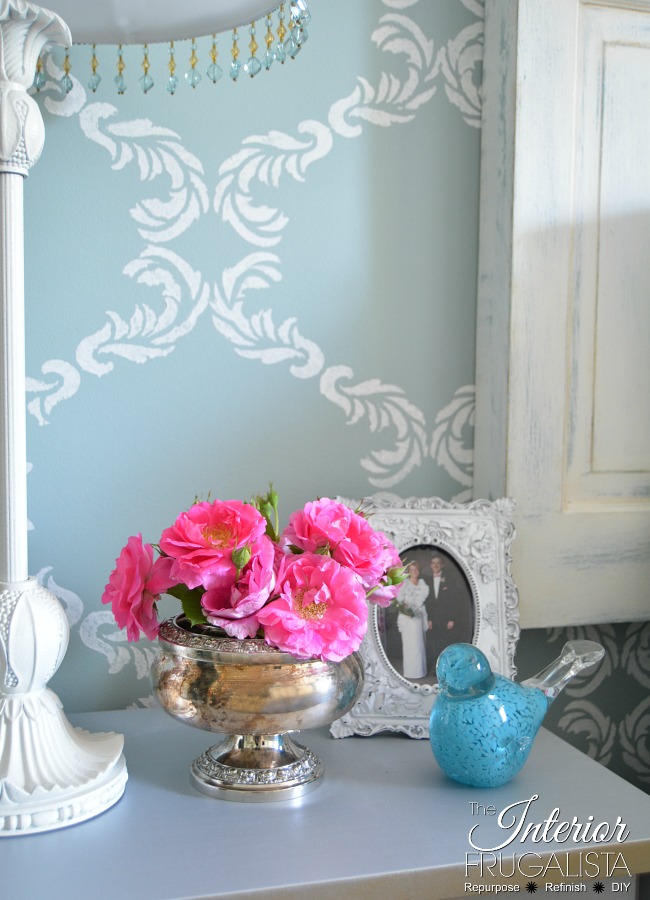12 Helpful Tips On How To Stencil A Wall
Does the thought of hanging wallpaper make you cringe? Then you've come to the right place because today I'm sharing a fabulous budget-friendly wallpaper alternative. It's surprisingly easy to do and perfect for an accent wall in any room of the house. If the thought of stenciling a wall makes you nervous, don't worry because in this post I'll be walking you through the dos and don'ts of wall stenciling. This beginner's guide includes 12 helpful tips on how to stencil a wall and believe me, if I could do it, you definitely can too!
I love a pretty papered wall but I do not enjoy hanging it nor do I like the cost of those pretty papered rolls. So when we tackled the master bedroom makeover and I wanted to create a lovely focal wall, I went in search of another option.
I'd never done stencil painting on walls before and being a dig right in before learning the proper ropes kinda gal, it's no surprise I ran into some snags. So today I'm sharing the mistakes I made and the lessons I learned through trial and error so you can do it right the first time.
This post contains affiliate links so you can see what products I used or recommend for this project. As an Amazon Associate, I earn a small commission from qualifying purchases at no extra cost to you.
If you don't have fresh paint on the walls, this is the time to do any paint touch-ups.
After you've washed and repaired any perfections on the wall, you want to mask the ceiling, baseboards and adjacent walls with painter's tape (pictured below).
Note: Don't use masking tape or you risk peeling the wall paint, especially if it's a freshly painted wall.
If you're confident in your stenciling skills, depending on the stencil, you can get real fancy and add multiple colors.
So what do you think, would you attempt stenciling a wall after reading these helpful tips?
I've had many of you ask about the paint color on the wall. It's Benjamin Moore's, Wedgewood Gray HC-146.
You've also asked about the headboard. You can find it here in my How To Turn An Old Door Into A Headboard post. The night tables are also DIY projects. The one with the curvy legs on the left was a legless Mid-Century Modern Cabinet and the one on the right was a Box Store Table Makeover.
If you have any questions about this large wall stencil technique, please leave them in the comment section below or the Contact Me tab at the top. I love hearing from you!
If you enjoyed this tutorial, I'd be so thankful if you pinned and shared it with a friend.

I share my projects at these inspiring link parties.
12 Helpful Tips On How To Stencil A Wall
I love a pretty papered wall but I do not enjoy hanging it nor do I like the cost of those pretty papered rolls. So when we tackled the master bedroom makeover and I wanted to create a lovely focal wall, I went in search of another option.
I'd never done stencil painting on walls before and being a dig right in before learning the proper ropes kinda gal, it's no surprise I ran into some snags. So today I'm sharing the mistakes I made and the lessons I learned through trial and error so you can do it right the first time.
Beginners guide for stenciling a wall
This post contains affiliate links so you can see what products I used or recommend for this project. As an Amazon Associate, I earn a small commission from qualifying purchases at no extra cost to you.
Supplies
- Chelsea All Over Stencil
- Stencil Level
- Stencil Kit (4-inch dense foam roller and brush)
- Small Paint Tray
- Painter's tape
- Wicker White Acrylic Paint
- Cardboard or Paper Towels
- Shop Towels
- Step Ladder
Prep the walls
If your walls don't have a fresh coat of paint on them, give them a good scrub with 1 cup of Borax to 1 gallon of water. This is my go-to wall cleaning solution for streak-free walls. You will want to wear rubber gloves.If you don't have fresh paint on the walls, this is the time to do any paint touch-ups.
After you've washed and repaired any perfections on the wall, you want to mask the ceiling, baseboards and adjacent walls with painter's tape (pictured below).
Note: Don't use masking tape or you risk peeling the wall paint, especially if it's a freshly painted wall.
Tip 1 - Read the instructions
Unlike what I did, before starting read the instructions that come with the stencil!Tip 2 - Order the level
Don't skip costs, like I did, and DO order the recommended stencil level. I regrettably learned very quickly that it isn't just a gimmicky gadget and a MUST when stenciling an entire wall. I promise you won't regret it.Tip 3 - Where do I start stenciling the wall
Start at the center of the wall and mark it at the ceiling with chalk or a pencil. If there is a window or door in the center then start the stencil where you have no interruptions from top to bottom.Tip 4 - Where is the center?
Find the center of the pattern on the stencil and NOT the center of the stencil. If the center isn't already marked on the stencil, then mark it with either a permanent marker or cut a small notch.Tip 5 - Should I use a level?
Clip-on the level at either the top or bottom of the stencil.Tip 6 - How to align the stencil
Starting at the top of your wall, align the center mark on the stencil with the center mark on the wall. Adjust the stencil until it is level and tape firmly in place using painter's tape. Don't panic is there is a gap between the ceiling and the stencil. We'll address that in step 12.Tip 7 - Option 1: Stencil with a roller
Note: You will use more paint with this method and have to clean the stencil more often.- Pour either acrylic or latex paint into the small paint tray.
- Offload the paint on a piece of cardboard or doubled paper towel until the roller looks almost dry.
- With light to medium pressure roll the brush over the stencil.
- Once you are happy with the coverage move on to Tip 9.
Tip 8 - Option 2: Stencil with a brush
Note: This method will take much longer but you will use less paint. One 2 fl oz/59 ml bottle of acrylic craft paint-covered an entire row on my wall.- Pour acrylic craft paint onto a styrofoam plate.
- Dip a round stencil brush into the paint and dab the excess onto a piece of cardboard or doubled paper towel until the brush looks almost dry.
- Pounce or brush the paint in a circular motion with a large stencil brush.
- Once you are happy with the coverage move on to Tip 9.
Tip 9 - Which direction should I stencil?
- Start your first row working downward from the top of the wall in a vertical row.
- Before repositioning the stencil always wipe the back of the stencil with a baby wipe to remove any paint that may have seeped through.
- Reposition the stencil right below the first pattern using the registration marks (triangle shapes) on the stencil.
- Make sure the pattern is lined up perfectly with the previously stenciled pattern.
- Check the level and adjust accordingly.
Tip 10 - Make sure not to double stencil
Once you have the stencil lined up, don't make the mistake of stenciling over the exposed painted areas from the previous row.Tip 11 - What to do in the corners of the wall
When you reach a corner, bend the stencil where it meets the corner and tape in place on the opposite wall. You'll need to use your left hand to hold the stencil in place on the stenciled wall. Use a stencil brush to pounce or brush the paint into the crease.Tip 12 - What to do with any gaps
- If the wall isn't square, you will have gaps between the top and/or bottom of the wall.
- Allover wall stencils, like the one I used, come with a small stencil for this purpose.
- Stencil the gaps by lining the small stencil (or the large stencil if yours didn't come with the small one) with the previous stenciled pattern.
- Brush or pounce with a stencil brush.
Bonus Tip
It doesn't hurt to have a glass of wine nearby to help relax into this project. Earbuds and your favorite music make stenciling even more fun but be careful not to get too jiggy with it.If you're confident in your stenciling skills, depending on the stencil, you can get real fancy and add multiple colors.
So what do you think, would you attempt stenciling a wall after reading these helpful tips?
I've had many of you ask about the paint color on the wall. It's Benjamin Moore's, Wedgewood Gray HC-146.
You've also asked about the headboard. You can find it here in my How To Turn An Old Door Into A Headboard post. The night tables are also DIY projects. The one with the curvy legs on the left was a legless Mid-Century Modern Cabinet and the one on the right was a Box Store Table Makeover.
If you have any questions about this large wall stencil technique, please leave them in the comment section below or the Contact Me tab at the top. I love hearing from you!
If you enjoyed this tutorial, I'd be so thankful if you pinned and shared it with a friend.

I share my projects at these inspiring link parties.









I know! I know! - Lynn
ReplyDeleteHa ha ha Lynn, yes you do ;)
ReplyDeleteVery helpful guidelines! Can you please give some guidelines on choosing colors and what tones work best, light vs dark colors etc. Thank you!
ReplyDeleteWhen stenciling a wall you want to make sure there is a contrast. If your wall is a light color then you want to use a darker color for the stencil. You can use the same color but a darker tone for a more subtle look, or a complimentary color or two. If your walls are dark, like mine, then go with a light contrasting color or white, like I did. On white walls, a soft gray is very pretty and subtle where a dark gray is more dramatic. I hope this helps!
DeleteWhat’s best way to wipe off if I mess up a part while stencil…
ReplyDeleteIf you are using latex, acrylic, or water-based paint then while it is wet, wipe that area with either a damp cloth or Q-tip for defined areas. The other option is to wait until the paint is dry and carefully go over the mistakes with the wall or background color using an artists brush. I hope this helps!
Delete